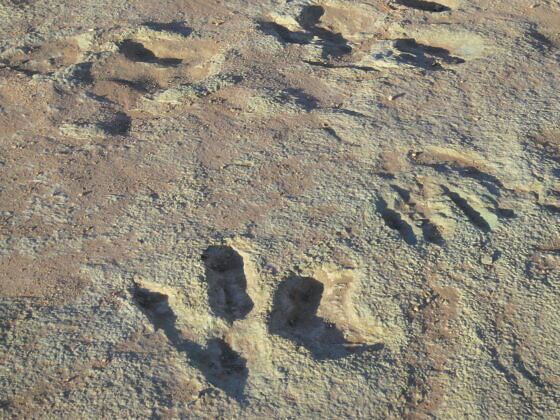The Mill Canyon Dinosaur Tracksite just north of Moab in Utah is one of the largest and most important Early Cretaceous tracksites in the world, with more than 200 tracks and trace fossils of at least 10 different animals. It also happens to be a major tourist attraction. But during the construction of a new tourist boardwalk to view said tracks, some were run over by construction equipment.

Photos: 112-Million-Year-Old Dinosaur Tracks Permanently Damaged While Building Tourist Walkway
A report from the Bureau of Land Management found that, in January, construction equipment like backhoes impacted tracks and traces that were once destinations for fossil chasing tourists. The ones that were broken or eroded can’t be saved. The ones that got microfractures from the weight of machinery will more quickly degrade from the elements.
The tire tracks are on the sauropod tracks. There is an iguanadon track there, too. They’re literally driving on these. pic.twitter.com/9hLHK2v5LY
— Jeremy Roberts (@JeremyBRoberts) January 30, 2022
The fossils and tracks are from the Early Cretaceous period about 112 million years ago. Theropods, sauropods, ornithopods, ankylosaurs, birds, and crocodiles are some of the tracks and fossils left behind that people could view and researchers could study. Some of the animals were unknown to the area before being spotted here. It’s all part of why the Mill Canyon Dinosaur Tracksite is ranked as a top-10 dinosaur tracksite in the United States, the BLM report notes.
One of the losses was a crocodile slide track that, as tire marks show, was repeatedly driven over and fractured.
This is the ONLY lower Cretaceous trackway site in Utah. It has more species diversity than any tracksite in America. In terms of years, we are currently closer in years to this site than a living T-Rex was to it. This pic was a crocodilian resting trace that’s been driven over. pic.twitter.com/7jzW0eN5h8
— Jeremy Roberts (@JeremyBRoberts) January 30, 2022
It could have been a lot worse. Locals noticed the tire marks over areas with dinosaur tracks and were able to halt the new walkway.
According to the bureau, the good news was that the damage was evaluated as minor, and would have been much worse if local residents had not spotted tire tracks from heavy machinery on the ground, resulting in the boardwalk project being immediately halted.
“I’m absolutely outraged that the BLM has apparently destroyed one of the world’s most important paleontological resources,” Patrick Donnelly, Great Basin director at the Center for Biological Diversity, said in a statement. “This careless disregard for these irreplaceable traces of the past is appalling. It really calls into question the Bureau’s competence as a land-management agency.”
Needless to say, destroying the very thing that you’re building a viewing platform for visitors to see is not ideal planning.